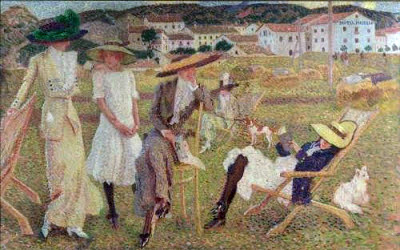He was a prodigy, there was no doubt; certainly his father believed in him from the beginning. He did poorly in school, being the kind of student that teachers described as being adrift with the clouds. When one of his art teachers humiliated him in class, Michele Cascella stopped going to school entirely. This caused a crisis in the family; the boy's mother wanted him to make a religious vocation but the father, who supported the boy's artistic ambitions, won out.
As an adult, Michele Cascella (1892-1989) credited Vincent van Gogh and Raoul Dufy as his artistic influences and, while it makes a good parlor game to tease out the visual bits he took from each of them, no influence is sufficient to explain his skills in painting, drawing, lithography, and ceramics. When I look at Orangerie, painted when Cascella was just eighteen, I see the lines used to describe the girl's skirt as coming straight out of Dufy, the lines and the colors working together but not in the usual academic way. Cascella is fearless in using bright colors (his debt to Van Gogh) without ever letting them overwhelm this tranquil, workday scene. The
house in Abruzzo, clad in stucco, is shown here in stark white,
probably an indication of the midday sun. The country house and the orange grove were often Cascella's subject but seldom more effectively than in Orangerie. He usually depicts orchards as pure landscape, absent their human gardeners. Here he shifts the focus to a young girl at work, staking and pruning, his subject, underlining the domestic element that makes a landscape out of nature. Her pose appears, appropriately, reverential in this Edenic setting.
Caseclla was born in Ortona, a city on the Adriatic Sea, in 1892. His father Basilio, a polymath, was an engraver, ceramist, lithographer
and illustrator, was the boy's first teacher. Basilio's career was given a boost when he given a plot of municipal land to build a laboratory and art studio for his lithography business. Michele's first job at his father's business was the painstaking task of filling in backgrounds on lithographic stones. But his father also gave him more traditional art projects such as copying drawings of the old masters. Unable to draw well himself from nature, Basilio sent Michele and his brother outdoors, supplied with a box of pastels, chocolate and cheese, to paint. That Michele far outstripped his younger brother appears to have caused not too much rancor.
When Basilio judged that the boy was ready to exhibit in public, he arranged a show in Milan for the fifteen year old (this was in 1902), followed by a show in Paris the next year where Michele sold his first painting. At eighteen Michele Cascella was ready to take his place among the cultural set in the city.
In another prodigious move, the twenty year old artist began an affair with thirty-eight year old Sibilla Aleramo, one of Italy's most famous writers and already the author of the feminist classic A Woman (1906). (I read the novel in college but confess to only a vague memory of it at this point.)
Cascella's career would be long and varied, not a footnote to youthful achievement as are those of some who succeed early. He won a gold medal for painting at the 1937 Paris Exposition Universelle, where Raoul Dufy created a sensation with his multi-panel mural La fee electricitee. Cascella made his first visit to the United States in 1959 and thereafter spent six month of each year at Palo Alto, California. In 1977 the City of Ortuna re- dedicated their art museum to Cascella; more than five hundred works by three generations of the family are included in its collection. When he died at age ninety-seven in Milan, he was buried in his hometown of Ortona.


